How Healthy Are Our Watersheds?
Ways to Protect Our Watersheds
Stream Buffers
-Riparian Buffer & Rain Garden
-Buffer Handbook
-Sources of native plants
Upper Thornton River Watershed Study
RappFLOW is a member of the Orion Grassroots Network
Report to Planning Commission on
Survey of Landowners
and Residents in the
Upper Thornton River Watershed
Beverly Hunter <bev@rappflow.org>
On January 30, 2006, RappFLOW volunteers mailed 1500 surveys to all known addresses of residents and landowners in the Upper Thornton River Watershed, identified by one of thirteen subwatersheds. Respondents were offered a free aerial photo of their property as an incentive to return the survey.
This report provides highlights from preliminary tabulation of 157 filled-in surveys. Also suggested here are some questions for further analysis. Results are still being analyzed and we will have a more complete report in a few weeks. Comments and questions are welcome.
What are the purposes of the survey?
-
Learn from residents and landowners what are their interests and concerns about their local watersheds. RappFLOW will apply this information to its assessment of the 13 subwatersheds in the Upper Thornton Watershed.
-
Determine priorities for RappFLOW volunteer efforts based on the concerns and knowledge of a broad spectrum of citizens.
-
Provide information to county leaders about the concerns and priorities of a broad spectrum of citizens with regard to watershed protection and health.
-
Expose citizens to watershed and water quality concepts and issues, and identify needs for public education regarding these issues.
-
Encourage a broad range of citizens and community leaders to become more engaged in watershed management activities and practices.
This work is supported in part by the National Fish and Wildlife Foundation and 15 partner organizations. For more information please see www.rappflow.org
Who completed the survey?
Respondents to the survey pro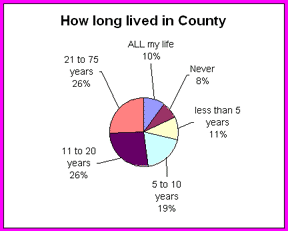 vide a good spectrum in terms of whether and
how long they have lived in Rappahannock County. As shown in the following
chart, 36 percent have lived here either “all my life” or over
20 years.
vide a good spectrum in terms of whether and
how long they have lived in Rappahannock County. As shown in the following
chart, 36 percent have lived here either “all my life” or over
20 years.
The respondents as a group hold over 10,000 acres of land. The respondents
represent different sizes of land holdings, from a small lot in a village
to a 1,000 acre farm and all sizes in between, as shown in the chart below.
Eighty-
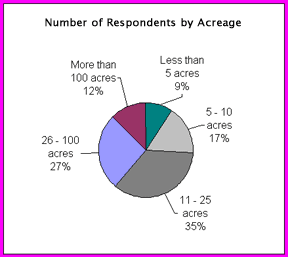 three percent of the respondents have at least one stream on their
property; 38 percent have a pond.
three percent of the respondents have at least one stream on their
property; 38 percent have a pond.
Questions for further analysis:
-
How representative of the entire Upper Thornton Watershed is our respondent group, in terms of size of land holdings? We will estimate this by reviewing the parcels database for the Upper Thornton area and grouping the parcel sizes.
-
Does the percentage of respondents vary by subwatershed? This can be estimated by dividing the number of respondents within subwatershed by the total number of addresses mailed within subwatershed, minus the addresses that were “returned to sender.”
How do respondents use their land?
The survey lists 17 possible land uses and asks respondents to check all that apply to their property. The three most frequently checked uses are Residence (136), Gardens for personal use (111), and Family recreation (103). Only 14 respondents reported “Growing crops for sale;” 23 reported “Raising animals for sale or commercial use;” 30 listed “Grazing.” Eight wrote in “making hay” as another use.
The chart below shows the total number of responses for categories of land use. “Recreational” includes horseback riding, hiking, biking, and family recreation. “Water Recreation” includes fishing, boating and swimming.
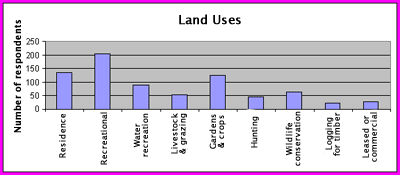
Questions for further analysis:
-
In what ways do respondents’ land uses correlate with the values, issues, and threats that concern them?
-
How representative is our respondent group with respect to land uses in the Upper Thornton watershed? One source for comparison is the real estate tax database, which indicates whether a parcel is in land use taxation. The percentage of land use parcels can be compared to the percentage of respondents’ land uses that would qualify for land use taxation. Is the relatively low percentage of agricultural land uses in our survey, representative of the actual percentage of agricultural land uses in the Upper Thornton watershed?
What do we most value in our watershed?
The survey offers 17 answers for what a person values the most in their watershed, and asks respondents to check the THREE most important to them.
Scenery (82), Privacy (77), and Quality of life (77) are the three answers most frequently chosen by respondents. Income from farm (7) or Income from forest (1) were chosen as highest priority values by very few respondents.
The chart below shows the total number of responses by values grouped in categories.
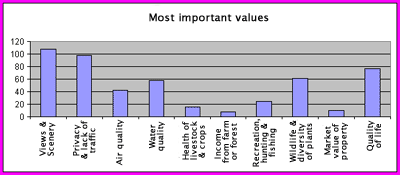
What water issues concern us the most?
The survey offers 12 water issues of possible concern. Out of these, quality and/or quantity of drinking water is the most important issue to the most people. Water for livestock is a major concern to only eight percent of respondents. Need to clean up Chesapeake Bay is a major issue for 22 percent of respondents.
The first 157 respondents answered question 7 in the following way:
Question 7: Three water issues that concern me the most are the following:
Answer choice |
# out of 157 choosing |
b. quality of well water |
95 |
a. adequate supply of good drinking water |
83 |
h. bacterial contamination of stream water |
56 |
g. trash in the streams |
40 |
l. need to help clean up the Chesapeake Bay |
35 |
j. nutrients (nitrogen and phosphorus) in streams and ponds |
31 |
f. stream bank erosion |
30 |
k. loss of fish species in waterways |
26 |
e. sediment in streams and ponds |
19 |
d. floods |
18 |
c. sufficient water for livestock |
13 |
i. algae in ponds |
7 |
Questions for further analysis:
-
Are there differences among the 13 subwatersheds with regard to the issues? Determine this by analyzing the responses to question 7 within subwatershed of respondent. Then check statistical significance of the differences.
What are the highest priority threats to our watershed?
The survey offers 19 threats to the watershed, and asks respondents to choose the THREE that concern them the most. The three threats of most concern to the most people include: Population growth (32%); Subdivision of land parcels (32%); and Public sewage treatment plant discharge to streams (29%). More than a third of respondents to question 7 said that “bacterial contamination of stream water” is a major issue, but fewer than 10% said in question 8 that livestock in streams and ponds is a major concern to them, and lack of forested buffers along streams and ponds is a most important threat to only 17 respondents.
The first 157 respondents answered question 8 as follows:
m. subdivision of land parcels |
51 |
l. population growth |
50 |
b. public sewage treatment plant discharge to stream |
45 |
e. pesticides and herbicides |
41 |
a. septic tanks & other private sewage disposal |
31 |
k. commercial development |
27 |
g. loss of farms |
25 |
n. agricultural runoff (nutrients) |
21 |
s. invasive species |
20 |
c. erosion and sedimentation from driveways and private roads |
20 |
i. conversion of forests to other land uses |
19 |
p. lack of forested buffers along streams and ponds |
17 |
f. livestock in streams and ponds |
16 |
d. stormwater runoff |
15 |
h. clear cutting of forests |
15 |
j. traffic |
11 |
q. stream bank erosion |
11 |
o. residential runoff (nutrients) |
6 |
r. wildlife in streams and ponds |
3 |
The responses reveal a need and opportunity for education regarding the relationships between riparian buffers and those issues that most concern people, such as clean and plentiful drinking water and bacterial contamination of stream water. The major concerns about population growth and land subdivision provide good opportunities for public education about conservation tools such as easements. The major concern about public sewage treatment plant effluent to stream, in contrast to low concern about lack of riparian buffers, provides good opportunities for education regarding STP effluent versus impact of land use practices.
Do we support public expenditures on watershed protection and restoration?
“I support expenditures of public money on watershed protection and restoration.” This statement was answered by 144 respondents. Of these, 92 percent answered “yes.”
What individual and community efforts do we encourage?
The survey offers 18 possible individual and community efforts on watershed protection. Respondents checked all items they encourage. Nearly all (153) respondents to the survey checked at least one of these items. The following chart shows the number of respondents who encourage certain efforts that are now or might be supported by our county government. Ordinances and zoning were chosen by even more respondents than were education items. Cluster development was selected by fewer than a third of the respondents.
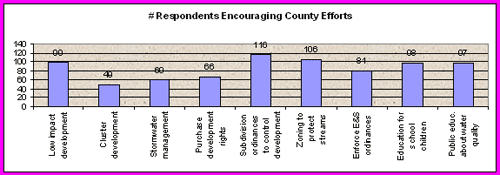
The following chart shows the number of respondents who encourage efforts typically undertaken by landowners, volunteers, or state agencies. Seventy-five percent (115) of respondents encourage conservation easements, which is consistent with the concerns about population growth and subdivision of land parcels in question 8.
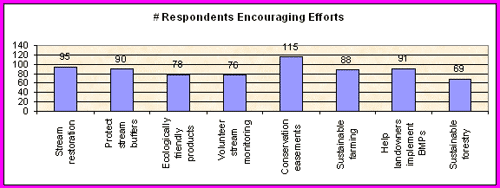
Plans for further analysis and interpretation.
The respondents to the survey represent a good spectrum of longevity in the county and size (acreage) of land holdings. We will check the representativeness of this sample through comparisons with other data sources, including the county real estate database.
The results will be tabulated by subwatershed, to see if there are patterns of participation, values, issues, threats that are specific to individual subwatersheds. Results by subwatershed will be incorporated into the Upper Thornton Watershed assessment.
We plan to write interpretive reports on the survey and publish them on the web and in the Rappahannock News.
RappFLOW leaders and volunteers will discuss the findings and their implications for our strategic plan and priorities for future work.
If the findings of this survey appear to warrant the investment, we may revise and improve the survey instrument and conduct the survey county wide.
We will make the survey instrument available to other similar communities in Virginia.
The surveys themselves are anonymous. However, about 80 respondents requested aerial photos of their property. We will follow up to invite them to participate in future watershed related activities.
